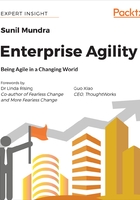
Enhancing agility is not the same as Agile transformation
Many enterprises are initiating Agile transformation initiatives, with the intent to enhance agility at enterprise level. However, Agile transformations usually mean scaling Agile practices across teams using a prescribed framework, implementing DevOps, changing the rigid structure to another rigid structure, and similar types of changes which not only aim for a fixed end state, but are also blindly copied from what purportedly is working for other enterprises.
The word transformation indicates moving from the current state to a new state, which is predicted in advance. This goes against the core philosophy of agility, which is to assume that a) the end state can be predicted in advance, and b) it is OK to remain in a fixed state.
Jurgen Appelo, author of the book, Management 3.0, has summarized an enterprise with high agility as follows:
"In the 21st century, successful organizations are hard and soft. Fast and slow. Solid and liquid. Organized and self-organized." [xii]
Adopting Agile, assuming that it is done correctly, is a good start on the journey towards agility. However, it is incorrect to believe that adopting Agile practices, methods, and frameworks is enough to create agility. As we will see in the later part of this chapter, and the subsequent chapters, the breadth and depth of the initiatives and changes required to enhance agility are very different from those needed to optimize delivery using Agile methodologies.